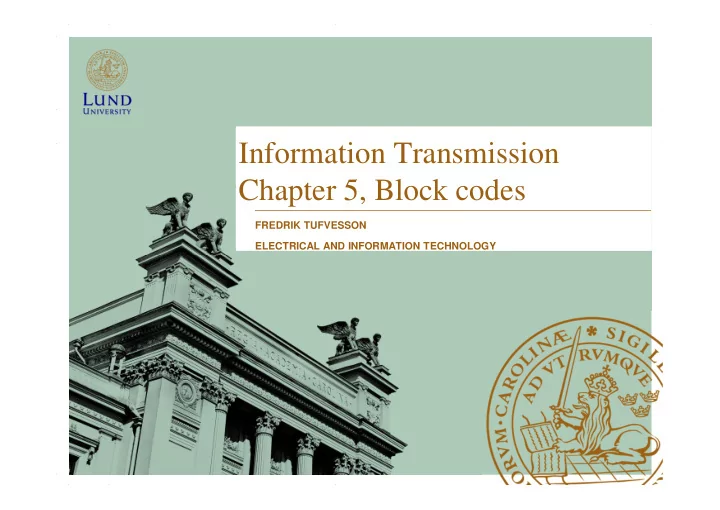

1 Information Transmission Chapter 5, Block codes FREDRIK TUFVESSON ELECTRICAL AND INFORMATION TECHNOLOGY
2 Methods of channel coding • For channel coding (error correction) we have two main classes of codes, namely: – block codes, which we first encountered when we discussed Shannon's channel coding theorem – convolutional codes. We shall briefly discuss both classes.
3 A schematic communication system
4 The binary field For the following calculations we use the binary field , for which the rules of addition and multiplication are those of modulo-two arithmetic: Notice that since 1+1=0, subtraction is the same as addition, which is very convenient
5 The error pattern Suppose that the codeword is transmitted over the binary symmetric channel and that is the possibly erroneously received version of it, then the error pattern is defined to be the N -tuple that satisfies If we have one error, that is, e consists of one 1 and N-1 0's, then one component in v is altered. Two errors cause two altered components in v .
6 Minimum distance The minimum distance , d min , of a block code B is the minimum of all the distances between two non-identical codewords of the code. If the sum of any two codewords is a codeword, then the code is said to be linear . For a linear block code the minimum distance is simply equal to the least number of 1's in a nonzero codeword In general, a block code with minimum distance d min will correct up ( d min -1)/2 errors. Alternatively, it can be used to detect up to d min -1 errors.
7 The (7,4) Hamming code Hamming constructed a class of single-error-correcting linear block codes with minimum distance d min =3. In the table we specify an encoder mapping for the (7,4) Hamming code with M=2 4 =16 codewords.
8 Example Assume that we would like to transmit the information 4- tuple u =(1011) over a binary symmetric channel. Then we encode it, by using the mapping in the table, and obtain the codeword v =(0110011). Let, for example, the sixth position be altered by the channel. Thus, we receive r =(0110001).
9 Example cont To correct the error we add position-wise modulo-two rows 2, 3, and 7 (the positions corresponding to the 1's in r ) and obtain that is, the binary representation of 6; we flip the sixth position in r =(0110001) and obtain the estimate of the codeword which corresponds to the information 4-tuple .
10 How does it work? (I) Why does our scheme work? We can write the received 7- tuple as the sum of the codeword and the error pattern, that is, r = v+e. Remember that 1+1=0! Due to this simple equality we can obtain the sum of the rows corresponding to the 1's in r by adding component- wise the sums of the rows corresponding to the 1's in v and e .
11 How does it work? (II) Now we exploit that the mapping in the table is constructed such that the sum of the rows corresponding to the 1's in any codeword is 000. Hence, we conclude that the sum of the rows corresponding to the 1's in r (this is the sum that the decoder computes) is equal to the sum of the rows corresponding to the 1's in e .
12 How does it work? (III) But assuming at most one error during the transmission we obtain in case of no errors the sum of zero rows which we interpret as 000 and then we accept r as our estimate In case of one error the sum contains one row, namely, precisely the row which is the binary representation of the position of the 1 in e . Hence, flip that position in r and we obtain our estimated codeword
13 The generator matrix How do we obtain the remarkable encoder mapping? Since the Hamming code is linear the codewords corresponding to the information 4 tuples 1000, 0100, 0010, 0001 are of particular interest; these codewords form a so- called generator matrix for the (7,4) Hamming code:
14 Codeword generation All codewords can be obtained as the product of the corresponding information 4-tuples and the generator matrix: For example, the codeword corresponding to u =(1011) is obtained as the position-wise modulo-two sum of the first, third and fourth rows in G , that is, in agreement with the mapping.
15 Generation of the parity check matrix Assume that we have a K x N generator G , then by the theory of matrices there exists an (N-K) x N matrix H such that It follows immediately that that is, we have the fundamental result Where H is the so-called parity check matrix.
16 The parity-check matrix In words, let v be a codeword, then if we add (position-wise modulo-two) the rows of H T corresponding to the 1s in v we obtain the allzero (N-K) -tuple. This computation is a parity-checking procedure and thus we call the matrix H a parity-check matrix of our code.
17 The generator matrix and the parity check matrix It is easily verified that Using linear algebra we can obtain the generator matrix G for a given parity-check matrix H and vice versa.
18
Recommend
More recommend